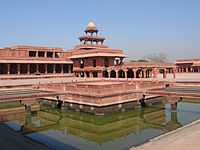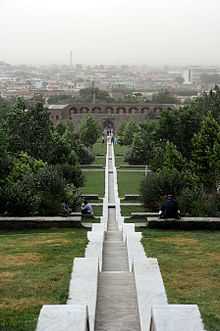Ruqaiya Sultan Begum
| Princess Ruqaiya | |
|---|---|
| Princess Ruqaiya born a Princess of Mughal, then its Empress | |
| Empress consort of the Mughal Empire | |
| Tenure | 1 February 1556 – 27 October 1605 |
| Spouse | Akbar |
| House | Timurid dynasty |
| Father | Prince Hindal Mirza of the Mughal Empire |
| Mother | Sultanam Begum |
| Born |
1542 Afghanistan |
| Died |
19 January 1626 (age 83-84) Agra, Mughal Empire |
| Burial | Gardens of Babur |
| Religion | Islam |
Ruqaiya Sultana Begum (Persian: رقیه سلطان بیگم; also spelled as Ruqayya, Ruqayyah) (1542 – 19 January 1626) was an Empress of the Mughal Empire. She was the first wife of Emperor Akbar.[1][2][3][4] She was also the longest serving Mughal empress having a tenure of over 49 years.[5]
She was born a Mughal princess (Shahzadi) and was the only daughter of Mughal prince Hindal Mirza, who was Akbar's youngest paternal uncle.[4] She was also the granddaughter of Emperor Babur, the founder of the Mughal Empire and the first Mughal emperor, as well as the niece of the second, Humayun.
She, Salima Sultana Begum and other senior begums played a crucial role in negotiating a settlement between her husband and her stepson, Jahangir, when the father-son relationship turned sour in the early 1600s, eventually helping Jahangir's accession to the throne.[6]
Family
Shahzadi Ruqaiya Sultan Begum was born into the Timurid dynasty as a Mughal princess, and was the only daughter of Mughal prince Hindal Mirza, the youngest son of the first Mughal emperor Babur from his wife Dildar Begum. Ruqaiya's mother, Sultanam Begum, was the daughter of Muhammad Musa Khwaja and the younger sister of Mahdi Khwaja, who was the brother-in-law of Emperor Babur, being the husband of his sister, Khanzada Begum.[7] Ruqaiya's oldest paternal uncle was the emperor Humayun, who later became her father-in-law as well, while her most notable paternal aunt was Gulbadan Begum, the author of Humayun Nama ("Book of Humayun").
Being the granddaughter of Emperor Babur and a Timurid princess, Ruqaiya, as well as her first cousin, Akbar, were descendants of the lines of the highest Central Asian aristocracy: Timur or Tamerlane the Great through his son Miran Shah, and Genghis Khan through his son Chagatai Khan.
As it was customary for a Mughal princess, Ruqaiya was well educated and knew many languages such as Chagatai, Persian, Arabic and Urdu.[8]
Marriage

At the age of nine, Ruqaiya married her half cousin, Akbar, in November of 1551 at Kabul, Afghanistan, shortly after his first appointment as a Viceroy in the province of Ghazni.[9] The marriage was arranged by Ruqaiya's uncle and Akbar's father, Humayun, and took place soon after the untimely death of Ruqaiya's father, Hindal Mirza, who died in a battle.[10] Humayun conferred on the young couple, all the wealth, army and adherents of his deceased younger brother, Hindal, and Ghazni, which was one of Hindal's jagir, was given to his nephew and son-in-law, Akbar.[10][11]
Ruqaiya became an Empress of the Mughal Empire at the age of fourteen years following her husband's accession to the throne in 1556.
Throughout her 53 years of marriage, Ruqaiya remained childless, but was given the primary responsibility for the upbringing of her grandson, prince Khurram (the future Emperor Shah Jahan).[12]
Just prior to Khurram’s birth, a soothsayer had reportedly predicted to Ruqaiya Sultan Begum that the still unborn child was destined for imperial greatness. So, when Khurram was born in 1592 and was only six days old, Akbar ordered that the prince be taken away from his mother and handed him over to Ruqaiya so that he could grow up under her care and Akbar could fulfill his aging wife's wish, to raise a Mughal emperor.[6] Khurram remained with her,[2] until he had turned 13. The young prince was then, finally, allowed to return to his father's household, and thus, be closer to his biological mother.[6] Ruqaiya oversaw Khurram's education as well for she, unlike her husband, was well educated.[13] Jahangir, noted that Ruqaiya had loved Khurram "a thousand times more than if he had been her own son".[2]
In 1607, Ruqaiya, for the first time, visited the mausoleum of her father Hindal Mirza as the royal harem and Jahangir were on a hunting trip to Kabul.[14] Sher Afghan Quli Khan, the jagirdar of Burdwan died and his widowed wife, Mehrunnissa (later Empress Nur Jahan) was summoned to Agra by Jahangir to act as lady-in-waiting to the Empress Ruqaiya.[9] Given the precarious political connections of Sher Afghan before his death, his family was in great danger and therefore for her own protection, Mihrunnissa needed to be at the court in Agra.
Nur Jehan and her daughter, Ladli Begum, served as ladies-in-waiting to the Empress for four years while earnestly endeavoring to please their imperial mistress.[15] The relationship that grew up between Ruqaiya and Mehr-un-Nissa appears to have been an extremely tender one which remained so until Ruqaiya's death in 1626. The Dutch merchant, Pieter van den Broecke said: "This Begum [Ruqaiya] conceived a great affection for Mehr-un-Nissa; she loved her more than others and always kept her in her company."[16]
Death
Ruqaiya died in 1626, at the age of 84 having outlived her husband by 20 years. She was buried on the fifteenth level in the Gardens of Babur (Bagh-e-Babur) in Kabul, which is also the resting place of her grandfather, Emperor Babur and her father, Hindal Mirza. Her tomb was built by her step-grandson, Emperor Shah Jahan.[17]
While recording her death in his autobiography, Jahangir fondly speaks of Ruqaiya, as she brought up his son, and makes note of her exalted status as Akbar's first wife.[18]
In popular culture
- Empress Ruqaiya is a main character in Indu Sundaresan's award-winning historical novel, The Twentieth Wife (2002), as well as in its sequel, The Feast of Roses (2003).[19]
- Ruqaiya is a main character in Ekta Kapoor's historical serial Jodha Akbar. The character is portrayed by Lavina Tandon.[20]
References
- ↑ Burke, S. M. (1989). Akbar, the greatest Mogul. Munshiram Manoharlal Publishers. p. 142.
- ↑ 2.0 2.1 2.2 Jahangir (1968). Henry Beveridge, ed. The Tūzuk-i-Jahāngīrī: or, Memoirs of Jāhāngīr, Volumes 1-2. Munshiram Manoharlal. p. 48.
- ↑ Lal, Ruby (2005). Domesticity and power in the early Mughal world. Cambridge University Press. p. 205. ISBN 9780521850223.
- ↑ 4.0 4.1 Emperor Jahangir; ed. Thackston, annot. by Wheeler M. (1999). The Jahangirnama : memoirs of Jahangir, Emperor of India. Oxford University Press. p. 437. ISBN 0195127188.
- ↑ Her tenure, from 11 February 1556 to 27 October 1605, was 49 years and 259 days
- ↑ 6.0 6.1 6.2 Faruqui, Munis D. Princes of the Mughal Empire, 1504-1719. Cambridge University Press. p. 148. ISBN 9781107022171.
- ↑ Faruqui, Munis D. (2012). The Princes of the Mughal Empire, 1504-1719. Cambridge University Press. p. 251. ISBN 1107022177.
- ↑ Prasad, Ishwari (1974). The Mughal Empire. Chugh Publications. p. 543.
- ↑ 9.0 9.1 Eraly, Abraham (2000). Emperors of the Peacock Throne : the saga of the great Mughals. Penguin books. pp. 123, 272. ISBN 9780141001432.
- ↑ 10.0 10.1 Ferishta, Mahomed Kasim (2013). History of the Rise of the Mahomedan Power in India, Till the Year AD 1612. Cambridge University Press. p. 169. ISBN 9781108055550.
- ↑ Erskine, William (1854). A History of India Under the Two First Sovereigns of the House of Taimur, Báber and Humáyun, Volume 2. Longman, Brown, Green, and Longmans. p. 404. ISBN 9781108046206.
- ↑ Robinson, Annemarie Schimmel (2005). The Empire of the Great Mughals : history, art and culture (Revised ed. ed.). Sang-E-Meel Pub. p. 149. ISBN 9781861891853.
- ↑ Rahman, Tariq (2002). Language, ideology and power : language learning among the Muslims of Pakistan and North India. Oxford University Press. p. 483. ISBN 9780195796445.
- ↑ Jahangir; ed.,, ; Thackston, annot. by Wheeler M. (1999). The Jahangirnama : Memoirs of Jahangir, Emperor of India. Oxford University Press. ISBN 9780195127188.
- ↑ Mohammad Shujauddin, Razia Shujauddin (1967). The Life and Times of Noor Jahan. Caravan Book House. p. 25.
- ↑ Findly, Ellison Banks (1993). Nur Jahan : Empress of Mughal India. Oxford University Press. p. 32. ISBN 9780195360608.
- ↑ Ruggles, Fairchild (2011). Islamic Gardens and Landscapes. University of Pennsylvania Press. p. 194. ISBN 9780812207286.
- ↑ Jahangir; ed.,, ; Thackston, annot. by Wheeler M. (1999). The Jahangirnama : Memoirs of Jahangir, Emperor of India. Oxford University Press. p. 437. ISBN 9780195127188.
- ↑ Kaur, Balwinder (April 15, 2012). "The power behind the throne". The Tribune. Retrieved June 28, 2013.
- ↑ Chaya Unnikrishnan (2013-06-26). "So far, so good". dnaindia.com. Retrieved 2013-12-04.
